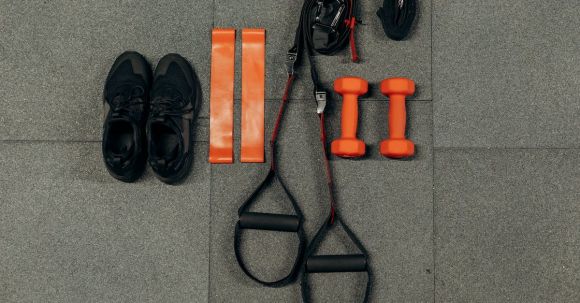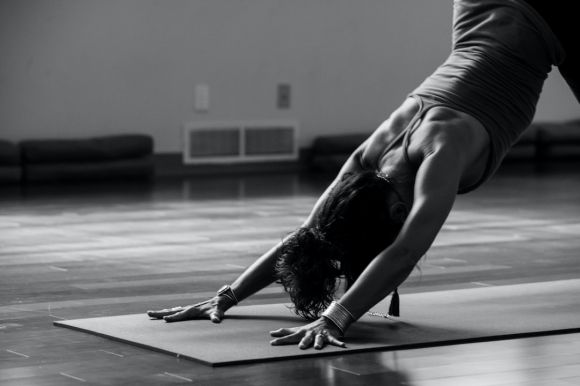In our fast-paced, modern world, it's easy to find ourselves mindlessly consuming food. Whether we're rushing through meals to meet deadlines or mindlessly snacking in front of the television, the act of eating has become a secondary concern. However, by practicing mindfulness in eating, we can transform our relationship with food and cultivate a healthier and more balanced approach to nourishing our bodies.
Blog Posts
Cardiovascular exercise, also known as cardio, is a form of physical activity that gets your heart rate up and improves overall fitness. It is an essential component of any workout routine and offers numerous health benefits. Whether you're a beginner or an experienced exerciser, it's important to know how to maximize the effectiveness of your cardio workouts. In this article, we will discuss some key strategies to help you get the most out of your cardio sessions.
Choose the Right Type of Cardio
There are various types of cardio exercises to choose from, such as running, cycling, swimming, and dancing. It's important to select an activity that you enjoy and that suits your fitness level. This will help you stay motivated and committed to your workouts. Experiment with different types of cardio to find what you enjoy the most and what challenges you physically.Set Clear Goals
Setting clear goals is crucial for making progress in your cardio workouts. Whether you want to improve your endurance, lose weight, or train for a specific event, having a clear objective in mind will help you stay focused and motivated. Set both short-term and long-term goals and track your progress regularly. This will allow you to celebrate your achievements and make adjustments to your workouts as needed.Warm Up Properly
Before starting any cardio workout, it's important to warm up your body properly. This helps increase blood flow to your muscles, improves flexibility, and reduces the risk of injury. Start with some light aerobic exercises, such as jogging in place or jumping jacks, for at least five minutes. Then, proceed to dynamic stretches that target the major muscle groups you'll be using during your cardio workout.Mix Up Intensity Levels
To get the most out of your cardio workouts, it's important to vary the intensity levels. Incorporate both low-intensity and high-intensity intervals into your training. Low-intensity exercises, such as brisk walking or slow cycling, are great for building endurance and burning calories. High-intensity exercises, such as sprinting or interval training, help improve cardiovascular fitness and increase calorie burn.Use Interval Training
Interval training is a highly effective way to maximize your cardio workouts. It involves alternating between periods of high-intensity exercise and periods of recovery. For example, you could sprint for 30 seconds and then walk or jog for one minute. Repeat this cycle for a total of 10-15 minutes. Interval training boosts your metabolism, increases fat burning, and improves cardiovascular fitness in a shorter amount of time.Monitor Your Heart Rate
Monitoring your heart rate during cardio workouts is a great way to gauge your intensity level and ensure you're working at an appropriate pace. To determine your target heart rate, subtract your age from 220 and multiply the result by 0.6 and 0.8. During your workouts, periodically check your heart rate and adjust the intensity as needed to stay within your target range.Fuel Your Body Properly
Proper nutrition is essential for getting the most out of your cardio workouts. Before exercising, fuel your body with a balanced meal or snack that includes carbohydrates for energy and protein for muscle repair. After your workout, replenish your body with a combination of protein and carbohydrates to aid in recovery. Stay hydrated throughout your workouts by drinking water before, during, and after exercise.Stay Consistent
Consistency is key when it comes to getting the most out of your cardio workouts. Aim for at least 150 minutes of moderate-intensity cardio or 75 minutes of vigorous-intensity cardio per week. Break it down into smaller, manageable sessions that fit your schedule. Remember, even short bursts of activity can add up and contribute to your overall fitness.Conclusion
By choosing the right type of cardio, setting clear goals, warming up properly, varying intensity levels, using interval training, monitoring your heart rate, fueling your body properly, and staying consistent, you can maximize the effectiveness of your cardio workouts. Remember to listen to your body, take rest days when needed, and have fun while exercising. With these strategies in place, you'll be well on your way to achieving your fitness goals and reaping the many benefits of cardiovascular exercise.
In today's fast-paced world, staying fit and maintaining a healthy weight can be quite challenging. With busy schedules and limited time, people often struggle to find effective ways to reach their fitness goals. However, with the rise of Fit on programs, getting fit and losing weight has become more accessible and achievable than ever before.
What are Fit on programs?
Fit on programs are comprehensive fitness and weight loss programs that offer a combination of exercise routines, meal plans, and expert guidance to help individuals achieve their fitness goals. These programs are designed to cater to different fitness levels and provide customized solutions for each individual's needs.The benefits of Fit on programs
1. Varied and engaging workouts
One of the main advantages of Fit on programs is the wide variety of workouts they offer. From high-intensity interval training (HIIT) to yoga and pilates, these programs provide a range of options to keep your workouts interesting and prevent boredom. With new workouts regularly added to the program, you'll never run out of exciting exercises to try.2. Expert guidance
Fit on programs are created by fitness experts who understand the science behind effective workouts and weight loss. With their guidance, you can be confident that you're following a well-structured program that will yield results. These experts also provide tips and advice on proper form, nutrition, and lifestyle changes to support your fitness journey.3. Convenience and flexibility
One of the biggest challenges people face when trying to get fit is finding time to exercise. Fit on programs address this issue by offering flexible workout options that can be done at home or on the go. Whether you have 10 minutes or an hour to spare, you can easily fit in a workout that suits your schedule.4. Customizable meal plans
Fit on programs understand that exercise alone is not enough to achieve optimal weight loss. That's why they also provide customizable meal plans that are designed to support your fitness goals. These plans take into account your dietary preferences and restrictions, making it easier to follow a balanced and nutritious diet.5. Community support
Embarking on a fitness journey can be daunting, but Fit on programs provide a supportive community where you can connect with like-minded individuals who are also working towards their fitness goals. The community aspect of these programs can be incredibly motivating and help you stay accountable to your goals.How to choose the right Fit on program for you
With so many Fit on programs available, it's important to choose one that aligns with your goals and preferences. Here are a few factors to consider when selecting a program: 1. Fitness level: Ensure that the program you choose caters to your current fitness level. Whether you're a beginner or an advanced exerciser, there should be options available to challenge you appropriately. 2. Variety: Look for a program that offers a wide range of workouts to keep you engaged and motivated. 3. Expertise: Research the credentials and expertise of the program creators to ensure you're getting guidance from qualified professionals. 4. Reviews and testimonials: Read reviews and testimonials from individuals who have completed the program to get an idea of its effectiveness.Conclusion
Fit on programs have revolutionized the way we approach fitness and weight loss. By providing varied workouts, expert guidance, convenience, customizable meal plans, and a supportive community, these programs offer a holistic approach to achieving your fitness goals. Whether you're a beginner or an experienced exerciser, there's a Fit on program out there that can help you get fit and lose weight effectively. So why wait? Start your fitness journey today with a Fit on program and see the results for yourself.
Are you ready to take your fitness journey to the next level? Look no further than the Fit on 7-day Fitness Challenge! This challenge is designed to push your limits, test your endurance, and help you achieve your fitness goals in just one week. With a combination of intense workouts, healthy eating, and a positive mindset, you will be well on your way to a healthier and stronger you. Let's dive in!
Setting Your Goals
The first step to success is setting clear and realistic goals. Before starting the challenge, take some time to think about what you want to achieve. Do you want to lose weight, gain muscle, or improve your overall fitness level? Once you have your goals in mind, write them down and keep them somewhere you can see them every day. This will help keep you motivated throughout the challenge.Creating a Workout Plan
Now that you have your goals set, it's time to create a workout plan that will help you achieve them. The Fit on 7-day Fitness Challenge provides you with a variety of workouts to choose from, including cardio, strength training, and flexibility exercises. Mix and match these workouts to create a plan that works best for you. Remember to challenge yourself but also listen to your body and rest when needed.Fueling Your Body
Exercise alone is not enough to achieve your fitness goals. You also need to fuel your body with the right nutrients. During the 7-day Fitness Challenge, focus on eating a well-balanced diet that includes lean proteins, fruits and vegetables, whole grains, and healthy fats. Avoid processed foods and sugary drinks, as they can hinder your progress. Stay hydrated by drinking plenty of water throughout the day.Staying Motivated
Staying motivated is key to completing the challenge. Find ways to keep yourself engaged and excited about your fitness journey. One way to do this is by tracking your progress. Take measurements and photos before and after the challenge to see how far you've come. Celebrate your small victories along the way, whether it's completing a challenging workout or making healthier food choices. Surround yourself with a supportive community of like-minded individuals who can cheer you on and provide encouragement when you need it.Pushing Through Challenges
No fitness journey is without its challenges. There will be days when you feel tired, unmotivated, or even sore. It's important to push through these challenges and stay committed to your goals. Remind yourself why you started in the first place and focus on the positive changes you are making in your life. Take each day as it comes and remember that progress is not always linear. Stay consistent and trust the process.In Conclusion
The Fit on 7-day Fitness Challenge is an opportunity for you to take control of your fitness journey and make a positive change in your life. Set clear goals, create a workout plan, fuel your body with the right nutrients, stay motivated, and push through challenges. Remember, it's not about perfection, but progress. Take the plunge and dive into this challenge. Your stronger and healthier self awaits!
In today's fast-paced and stressful world, finding ways to enhance mindfulness and reduce stress has become more important than ever. One powerful tool that has been practiced for centuries is meditation. Meditation is the practice of focusing one's mind and achieving a state of calm and relaxation. It can be done in various ways, such as sitting in a quiet room, focusing on the breath, or repeating a mantra. In this article, we will explore the benefits of meditation and how it can help enhance mindfulness and reduce stress.
Improving Mindfulness through Meditation
Mindfulness is the state of being fully present and aware of one's thoughts, feelings, and surroundings. It is about paying attention to the present moment without judgment. Meditation is a proven technique to cultivate mindfulness. By practicing meditation regularly, individuals can train their minds to be more present and aware. This can lead to a greater sense of clarity and focus in daily life. One of the ways meditation enhances mindfulness is by promoting self-awareness. During meditation, individuals are encouraged to observe their thoughts and emotions without getting caught up in them. This practice helps develop a non-judgmental attitude towards one's inner experiences. Over time, this increased self-awareness can extend beyond the meditation cushion and into everyday life, allowing individuals to respond to stressors more skillfully.Reducing Stress through Meditation
Stress has become a common part of modern life, and its negative effects on both physical and mental health are well-documented. Fortunately, meditation has been shown to be an effective tool for reducing stress. When we meditate, our bodies enter a state of deep relaxation, which triggers the relaxation response. This response counters the physiological effects of stress, such as increased heart rate and elevated cortisol levels. Moreover, meditation helps individuals develop a greater sense of resilience and equanimity in the face of stress. By practicing mindfulness during meditation, individuals learn to observe their stressors without getting overwhelmed by them. This can lead to a shift in perspective, allowing individuals to respond to stress in a more calm and composed manner.Tips for Starting a Meditation Practice
If you're new to meditation, getting started can feel overwhelming. However, with a few simple tips, you can begin your meditation journey with ease: 1. Start with short sessions: Begin by setting aside just a few minutes each day for meditation. As you become more comfortable, gradually increase the duration of your sessions. 2. Find a quiet space: Choose a quiet and comfortable space where you can meditate without distractions. This could be a corner in your home, a park, or even a quiet room at work. 3. Focus on your breath: One of the simplest and most effective meditation techniques is to focus on your breath. Pay attention to the sensation of your breath as you inhale and exhale, allowing it to anchor you in the present moment. 4. Be patient and kind to yourself: Remember that meditation is a practice, and it takes time to develop. Be patient with yourself and approach your practice with kindness and compassion. In conclusion, meditation is a powerful tool for enhancing mindfulness and reducing stress. By practicing meditation regularly, individuals can cultivate greater self-awareness, develop resilience, and respond to stressors more skillfully. So, why not carve out a few minutes each day to sit in stillness and experience the transformative benefits of meditation?
Regular exercise is a vital part of maintaining a healthy lifestyle. It helps to improve cardiovascular health, build strength, and boost overall well-being. However, exercise-related injuries can occur if proper precautions are not taken. In this article, we will discuss some effective strategies to prevent and manage exercise-related injuries.
1. Warm up and cool down
Before starting any exercise, it is important to warm up your muscles. This can be done through light aerobic exercises such as jogging or jumping jacks. Warming up helps to increase blood flow to the muscles and prepares them for activity. Similarly, cooling down after exercise allows your heart rate to gradually return to normal and helps prevent muscle soreness.2. Use proper form and technique
Using the correct form and technique during exercise is crucial in preventing injuries. Improper form can put unnecessary strain on your muscles and joints, increasing the risk of injury. If you are unsure about the proper form for a particular exercise, consider seeking guidance from a certified fitness professional.3. Gradually increase intensity and duration
One common mistake people make is pushing themselves too hard, too soon. It is important to gradually increase the intensity and duration of your workouts to give your body time to adapt. Sudden increases in intensity or duration can lead to overuse injuries such as tendinitis or stress fractures. Listen to your body and give it the rest it needs.4. Incorporate rest days
Rest days are just as important as exercise days. They allow your body to recover and repair itself, reducing the risk of overuse injuries. Aim to have at least one or two rest days per week, depending on your fitness level and the intensity of your workouts. Use these days to engage in light activities such as walking or stretching.5. Cross-train
Engaging in a variety of activities can help prevent overuse injuries. Cross-training involves incorporating different types of exercises into your routine. For example, if you are a runner, consider adding swimming or cycling to your workout regimen. This helps to reduce the repetitive stress on specific muscles and joints.6. Listen to your body
Pay attention to any warning signs or pain during exercise. Pushing through pain can lead to serious injuries. If you experience persistent pain, stop the activity and consult a healthcare professional. It is better to take a break and address the issue early on rather than exacerbating the injury.7. Get proper nutrition and hydration
Proper nutrition and hydration are essential for maintaining overall health and preventing exercise-related injuries. Make sure to fuel your body with a balanced diet that includes a variety of nutrients. Stay hydrated by drinking water before, during, and after exercise. Dehydration can lead to muscle cramps and fatigue, increasing the risk of injury.8. Seek professional guidance
If you are new to exercise or have specific health concerns, consider seeking guidance from a healthcare professional or a certified fitness trainer. They can provide personalized advice and help you create a safe and effective exercise plan. In conclusion, preventing and managing exercise-related injuries requires taking proactive measures such as warming up, using proper form, gradually increasing intensity, incorporating rest days, cross-training, listening to your body, maintaining proper nutrition and hydration, and seeking professional guidance when needed. By following these strategies, you can minimize the risk of injuries and enjoy the benefits of regular exercise for years to come.
As an athlete, you know that to excel in your sport, you need to be in peak physical condition. While general fitness training is important, incorporating sports-specific workouts into your training routine can take your performance to the next level. By tailoring your workouts to the specific demands of your sport, you can enhance your strength, speed, agility, and overall athletic ability. Here are some tips to help you improve your game with sports-specific workouts.
Understanding the Demands of Your Sport
The first step in designing an effective sports-specific workout routine is to understand the specific demands of your sport. Different sports require different physical attributes and skills. For example, a basketball player needs to have explosive jumps and quick lateral movements, while a soccer player needs endurance and agility. By identifying the specific physical demands of your sport, you can design workouts that target those areas.Targeted Strength Training
Strength is a fundamental component of athletic performance. However, not all strength training exercises are created equal. To maximize your gains, focus on exercises that mimic the movements and muscle groups used in your sport. For example, if you're a tennis player, incorporate exercises that strengthen your core, upper body, and legs, as these are the areas most utilized in your sport. By targeting the specific muscles used in your sport, you can improve your power, stability, and overall strength.Speed and Agility Drills
Speed and agility are crucial for success in many sports. Incorporating speed and agility drills into your workouts can help you improve your reaction time, quickness, and change of direction. For example, if you're a football player, include cone drills, ladder drills, and shuttle runs to enhance your speed and agility on the field. These drills will not only improve your physical abilities but also enhance your game awareness and decision-making skills.Endurance Training
Endurance is key for sports that require sustained effort over a long period of time, such as long-distance running or cycling. To improve your endurance, include cardio exercises such as running, cycling, or swimming in your training routine. Additionally, consider incorporating interval training, where you alternate between high-intensity bursts and lower-intensity recovery periods. This type of training can help improve your stamina and ability to perform at a high level for extended periods.Flexibility and Mobility
Flexibility and mobility are often overlooked but are essential for preventing injuries and optimizing athletic performance. Incorporate dynamic stretching exercises into your warm-up routine to improve your range of motion and reduce the risk of muscle strains or tears. Additionally, consider incorporating yoga or Pilates into your training regimen to improve your overall flexibility and stability.Recovery and Rest
While training is important, it's equally important to allow your body time to rest and recover. Overtraining can lead to fatigue, decreased performance, and increased risk of injury. Make sure to include rest days in your training schedule and prioritize sleep to allow your body to recover and rebuild. Additionally, consider incorporating active recovery techniques such as foam rolling, massage, or light stretching to aid in muscle recovery and reduce post-workout soreness.Conclusion
Sports-specific workouts are a valuable tool for athletes looking to improve their game. By tailoring your training routine to the specific demands of your sport, you can enhance your strength, speed, agility, endurance, flexibility, and overall athletic performance. Remember to always prioritize proper form, listen to your body, and seek guidance from a qualified coach or trainer to ensure you're maximizing your potential and minimizing the risk of injury. So, lace up your shoes, grab your equipment, and get ready to take your game to new heights with sports-specific workouts.
Cardio workouts are an excellent way to improve your cardiovascular health, burn calories, and boost your overall fitness level. However, staying motivated during these workouts can be a challenge, especially if you find them monotonous or if you struggle with maintaining a consistent routine. Fortunately, there are several strategies you can employ to stay motivated and make the most out of your cardio sessions.
Set Clear Goals
Setting clear goals is crucial for staying motivated during cardio workouts. Without a clear objective, it can be easy to lose focus and become demotivated. Start by defining your goals, whether it's running a certain distance, improving your endurance, or losing a specific amount of weight. Write them down and keep them visible as a constant reminder of what you're working towards.Create a Playlist
Music has a powerful impact on our mood and can significantly enhance our workout experience. Creating a high-energy playlist filled with your favorite songs can provide a much-needed boost of motivation during cardio workouts. Choose songs with a fast tempo that make you feel energized and ready to push through any fatigue. Consider updating your playlist regularly to keep it fresh and exciting.Try Interval Training
Interval training is an effective way to keep your cardio workouts engaging and prevent boredom. Instead of maintaining a steady pace throughout your entire workout, alternate between periods of high-intensity exercise and lower-intensity recovery periods. This not only challenges your body but also keeps your mind engaged as you focus on the changing intervals. Experiment with different interval lengths and intensities to find what works best for you.Mix Up Your Routine
Repeating the same cardio workout day after day can quickly lead to boredom and demotivation. To combat this, mix up your routine by trying different activities or variations of your favorite exercises. If you enjoy running, try incorporating sprints or hill intervals into your routine. If you prefer indoor workouts, consider trying different cardio machines or taking a dance class. The key is to keep your workouts fresh and exciting to maintain your motivation.Find a Workout Buddy
Having a workout buddy can significantly increase your motivation and make cardio workouts more enjoyable. Choose someone who shares similar fitness goals and schedule regular workout sessions together. Not only will you have someone to hold you accountable, but you'll also have someone to share the experience with. Working out with a friend can make the time go by faster and provide an extra level of support and encouragement.Track Your Progress
Tracking your progress is essential for staying motivated during cardio workouts. Keep a record of your workouts, including the duration, distance, and any other relevant metrics. This will allow you to see your improvements over time and provide a sense of accomplishment. Additionally, consider using fitness apps or wearable devices that track your heart rate, calories burned, and other valuable data. These tools can provide real-time feedback and help you stay motivated as you see your progress unfold.Reward Yourself
Rewarding yourself can be a powerful motivator to keep pushing through your cardio workouts. Set small milestones along the way and reward yourself when you achieve them. It could be treating yourself to a massage, buying new workout gear, or enjoying a guilt-free cheat meal. Just make sure your rewards align with your fitness goals and don't undermine your progress. In conclusion, staying motivated during cardio workouts is crucial for achieving your fitness goals. By setting clear goals, creating an inspiring playlist, trying interval training, mixing up your routine, finding a workout buddy, tracking your progress, and rewarding yourself, you can stay motivated and make the most out of your cardio workouts. Remember, consistency is key, so keep pushing through even when motivation is low, and you'll reap the rewards of your hard work.
As an athlete, you are constantly looking for ways to improve your performance and take your game to the next level. One highly effective method is incorporating sports-specific workouts into your training regimen. By focusing on exercises and drills that mimic the movements and demands of your particular sport, you can enhance your athletic ability in a targeted and efficient manner.
Why Sports-specific Workouts Matter
Sports-specific workouts are designed to replicate the specific movements, skills, and physical demands of your sport. By tailoring your training to the unique requirements of your chosen activity, you can optimize your performance and minimize the risk of injuries. These workouts help improve your agility, speed, power, endurance, and overall athleticism, giving you a competitive edge on the field, court, or track.Enhancing Agility and Quickness
Agility and quickness are essential in many sports, such as basketball, soccer, and tennis. Sports-specific workouts can help improve these attributes by incorporating drills that focus on quick changes of direction, reaction time, and coordination. Agility ladder drills, cone drills, and lateral shuffle exercises are just a few examples of exercises that can enhance your agility and quickness.Boosting Speed and Power
Speed and power are crucial in sports like sprinting, football, and basketball. Sports-specific workouts can help you develop explosive speed and power through exercises such as sprints, plyometrics, and Olympic lifts. These exercises train your muscles to generate maximum force and explosiveness, allowing you to accelerate faster, jump higher, and overpower opponents.Building Endurance and Stamina
Endurance and stamina are vital for sports that require prolonged physical exertion, such as long-distance running, cycling, or swimming. Sports-specific workouts can improve your endurance by incorporating high-intensity interval training (HIIT) sessions and long-distance runs. These workouts push your cardiovascular system to its limits, improving your ability to sustain effort over extended periods.Improving Sport-specific Skills
In addition to physical conditioning, sports-specific workouts also focus on developing specific skills required for your sport. For example, a basketball player may incorporate shooting drills and dribbling exercises into their training routine, while a soccer player may work on passing accuracy and ball control. By regularly practicing these sport-specific skills, you can refine your technique and enhance your performance during games or competitions.Preventing Injuries
Sports-specific workouts not only improve your athletic ability but also help prevent injuries. By targeting the muscles and movements used in your sport, you can strengthen the areas that are most prone to injury. For instance, a runner may include exercises that strengthen the hips and knees to reduce the risk of common running injuries like IT band syndrome or shin splints. By proactively addressing potential weaknesses or imbalances in your body, you can minimize the likelihood of getting sidelined by injuries. In conclusion, sports-specific workouts are a valuable tool for athletes looking to elevate their performance. By tailoring your training to the specific demands of your sport, you can enhance your agility, speed, power, endurance, and sport-specific skills. Moreover, these workouts help reduce the risk of injuries, enabling you to stay in the game and continue pushing your limits. So, whether you are a basketball player, a runner, or a soccer player, incorporating sports-specific workouts into your training routine can transform your athletic ability and take you to new heights.
Are you ready to push your limits and take your fitness to the next level? If so, then it's time to enter the Fit on Marathon Challenge. This unique event is designed to test your endurance and help you reach new heights in your fitness journey. In this article, we will explore the benefits of participating in a marathon and provide you with some tips to help you prepare for this exhilarating challenge.









